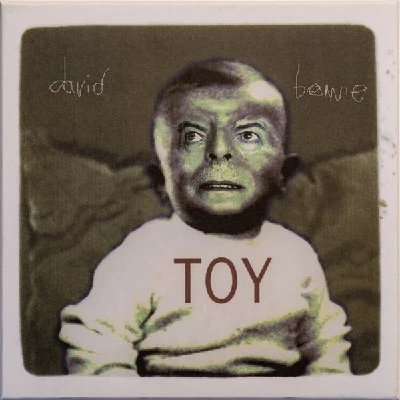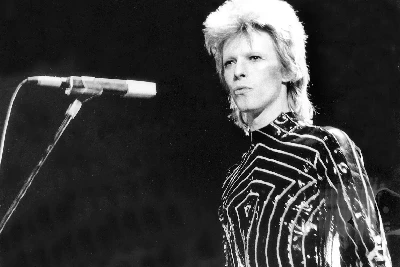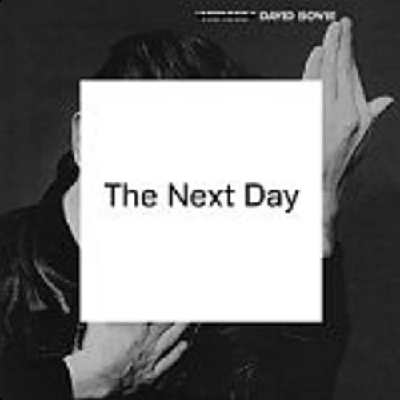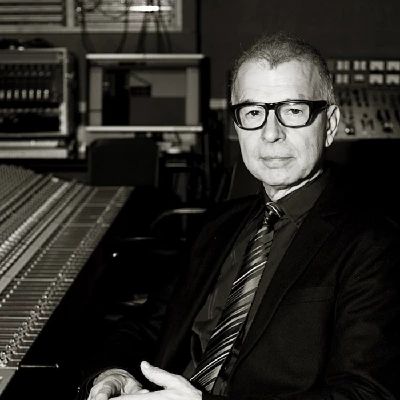'Discography Hagiography' The lives of music legends, one disc at a time #2. David Bowie - Part Two This retrospective of David Bowie’s work has taken more effort than I expected it would. Having covered his classic era, we’re now into the murkier waters of his work post-1980. There are undoubtedly some high points, but Bowie had some notorious missteps, particularly in the 1980s. This is a body of work that I’m less familiar with, so it should be an interesting voyage of discovery, though we’re starting with well-trodden territory. 'Scary Monsters (And Super Creeps)' (1980) David Bowie entered the 80s on a high, having produced some of the most brilliant albums of his career. Feeling the competition from young upstarts taking inspiration from his work on the Berlin trilogy, Bowie decided to go in a more commercial direction with his next album. And yes, ‘Scary Monsters’ is technically more commercial, but it’s also quite an abrasive record. Bowie has certainly taken influence from post-punk and new wave on this album – the influence of acts such as Talking Heads and Gang of Four can be heard in songs such as ‘Fashion’. ‘Ashes to Ashes’ channels the synth pop that was starting to take over the charts. Elsewhere, however, such as on the title track, the album seems to precede the sounds that would come popular a decade later, as alternative and indie rock. 'Let’s Dance' (1983) While ‘Let’s Dance’ is certainly a more commercial proposition than ‘Scary Monsters’ and does represent a slight dip in quality from that album, it’s still very good. The recruitment of Nile Rodgers as co-producer on the record is an inspired move, giving the record a sophisticated disco pop feel. The title track is undoubtedly a banger. ‘Modern Love’ took time to grow into a little, as did the cover of ‘China Girl’, which adds some very stereotypical ‘chinese’ melody parts to the arrangement that feel a little cheesy and hamfisted now. Elsewhere, ‘Ricochet’, ‘Criminal World’ and ‘Cat People’ are a strong run that still preserve some Bowie weirdness while reflecting the sound of the time. This marriage of art and pop sensibilities would soon turn sour, however. 'Tonight' (1984) This is a major turn for the worse for Bowie, and the first since his 1960's debut that I’ve disliked. It technically continues the trajectory set by ‘Let’s Dance’, but without the quality songwriting to back it up. The slightly overlong running time of some ‘Let’s Dance’ tracks feels like a bigger problem here, despite most of the tracks being shorter. The seven-minute ‘Loving the Alien’ meanders along before the terribly white reggae of ‘Don’t Look Down’ kicks in, followed by the lifeless cover of ‘God Only Knows’. The reggae moments in particular are an awful mistake, but there’s at least a little life to tracks like ‘Neighbourhood Threat’. 'Never Let Me Down' (1987) This is notorious for being the worst album of Bowie’s career, so I feel slightly wrong for liking it a bit more than ‘Tonight’. It’s not a good record by any means, but I found it more tolerable than its predecessor. Bowie is at least trying to recapture the art rock sensibilities that made him great, but it comes wrapped in some truly horrible production decisions. It’s certainly one of the most dated sounding albums in Bowie’s discography. It also contains some extremely pretentious moments, such as the spoken word intro on 'Glass Spider'. But tracks like ‘Beat of Your Drum’ have something about them. A few words on Tin Machine I was hoping to find that Tin Machine were just deeply misunderstood in their time, but .as much as I’ve tried, I just find it dull. I’m not going to cover their albums as we have enough to get through, but I’d say that it’s about as mediocre as Bowie gets. 'Black Tie, White Noise'/'The Buddha of Suburbia' (1993) Bowie’s first foray into dance culture is certainly a step up from his late 80s work, and the uplifting positivity that Bowie delivers, post-marriage to Iman, is appealing and infectious. Alongside the influence of early club music and hip hop, Bowie’s long standing interest in jazz sneaks in as well. Unfortunately, much of the sounds that Bowie experimented with were dated by the time the album came out. It also meanders a little in places, but it’s at least a step in the right direction. ‘Buddha of Suburbia’ does a similar thing, but more successfully. Created as a soundtrack to the television adaptation of Hanif Kureshi’s 1990 novel of the same name, it takes elements of dance and mixes them with rock and jazz in a more focused and engaging way than ‘Black Tie…’. While it does flit between styles, it still feels like a more substantial listen, and the instrumental moments give it a flavour of the Berlin trilogy. 'Outside' (1994) Influenced by die hard fans such as Nine Inch Nails’ Trent Reznor and hoping to recreate the heights of the Berlin era, Bowie brought back Brian Eno for ‘Outside’, the first of a planned trilogy. While it has its moments, it’s a bloated mess. The songs that are here, such as ‘The Heart;s Filthy Lesson’ and ‘Hallo Spaceboy’ distil the influence of alternative/industrial music into something that maintains what makes Bowie who he is. But the endless ‘Segue’ tracks, alongside a couple of overlong, dreary songs, make it a draining listen. 'Earthling ' (1997) Having abandoned the new trilogy after the muted response to ‘Outside’, Bowie turned to drum ‘n’ bass (DnB). At the time, I remember being slightly embarrassed by this 50-year-old rock star attempting to jump on the zeitgeist. Listening to it now, however, is a pleasant surprise. While its DnB moments are somewhat of the time, it’s combined with some solid songwriting. ‘Little Wonder’ is a catchy, odd little pop tune that transcends the ‘of the moment’ trappings of its arrangement. ‘Looking for Satellites’ is upbeat with hints of Britpop, while ‘Battle for Britain’ brings back both the NIN and the DnB influences together in a really successful way. ‘Seven Years in Tibet’, ‘Dead Man Walking’, ‘I’m Afraid of Americans’ – all mash late 70s Bowie with his 90s interests. It may not have been what every Bowie fan wanted at the time, but it’s a leap forward compared to what came before it. 'Hours' (1999) ‘Hours’ was praised in some corners for embracing a more “back to basics” approach than its preceding albums. It’s certainly a more introspective album than Bowie had released for a while, but it also sounds more dated than ‘Earthling’ in its production, which is extremely late 90s (as is its cover design). Overall, it’s quite a dull listen. ‘Thursday’s Child’ is a decent start, but it soon starts to melt into an indistinct mush. It’s competent, but one-note. ‘Seven’ is quite lovely, though. 'Heathen' (2002) Bowie entered a new decade more comfortable in his own skin, embracing his place as a legendary legacy act. With ‘Heathen’ it’s clear that Bowie was focused on creating quality songs, rather than trying to fit a certain sound; the result is a relaxed but melancholic art rock record. Bowie worked with Tony Visconti again for the first time since 1980, and the pair slipped back into a working relationship that can really deliver the goods. It’s also clearly an extremely personal and reflective album from Bowie, who played much of the instrumentation himself. The album also includes three great covers – ‘Cactus’ by Pixies, Neil Young’s ‘I’ve Been Waiting for you’ and ‘I Took A Trip on a Gemini Spaceship’ by Legendary Stardust Cowboy – that also demonstrate how much Bowie had taken the pressure off himself. Add in guest spots from the likes of Dave Grohl and Pete Townsend, and you’re on to a winner. 'Reality' (2003) Bowie continued where he left off on ‘Reality’, including the inclusion of covers among the originals. It’s a more rock-oriented, energetic affair than its predecessor, which some prefer, but I lean slightly more towards ‘Heathen’. By this point, Bowie was very much writing about ageing and reflections on what you might leave behind – this theme would only get stronger in his final works. This is an uplifting record, however. On ‘Never Get Old’, for example, Bowie almost pokes fun at his feelings about ageing, at once both defiant and uncertain. ‘The Loneliest Guy’ slows the pace a little, but otherwise, ‘Reality’ sticks with a bright, energetic sound, set up through opener ‘New Killer Star’. ‘She’ll Drive The Big Car’ is a particular personal high point. 'The Next Day' (2013) Ill health following a heart attack in 2004 resulted in David Bowie taking a step away from live performance and largely withdrawing from public life. Apart from the odd guest appearance, he lived a quiet life in New York city, before suddenly reemerging with ‘The Next Day’ a decade later. In many ways, it continues the trajectory set in place by ‘Heathen’ and ‘Reality’ – a solid, art rock sound, reflections on legacy and ageing, Visconti producing – but takes it further. It’s a more cohesive work than either record, and Bowie’s highest charting album in quite some time. Lead single ‘Where Are We Now?’ is gorgeous, looking back to his time in Berlin without overcomplicating it. ‘The Stars (Are Out Tonight)’ is a great, catchy counterpoint, and more reflective of the album as a whole. ‘Valentine’s Day’ harks back to Bowie’s glam heyday, but he follows it with ‘If You Can See Me’, which is a sort of off-kilter, artier version of his 90s work. This is ‘The Next Day’ in a nutshell – combining Bowie’s art and pop instincts into a varied but cohesive whole. 'Blackstar' (2016) Just over a year after releasing ‘The Next Day’, David Bowie was diagnosed with liver cancer. It sent him into creative overdrive; according to Visconti, his collaborator on his final album, he wanted to deliver a gift for his fans before he died. The album that he made is a masterpiece; beautiful, experimental and terribly sad. Bowie wanted to avoid rock on his final release at all costs, instead fully embracing jazz and electronic music. Opening with its ten-minute title track, ‘Blackstar’ warrants close listening. Its emotional and musical layers can be overwhelming, but also absorbing. ‘Sue (Or In A Season Of Crime)’ takes a slightly more rock-oriented direction, but is anomalous compared to the rest of the album. There’s a sense of urgency to ‘Blackstar’ – it’s not languid and mournful by any means – but also regret, sadness and ultimate acceptance. It’s a fine and fitting end to a life well-lived, and a musical career that never stood still. David Bowie was always willing to try something new, to keep pushing the boundaries of his work until the last. ‘Blackstar’ came out on his 69th birthday. Three days later, he was dead. Even now, more than seven years later, it’s hard to believe that he’s truly gone.
Also In Discography Hagiography
Band Links:-
http://davidbowie.com/blackstar/https://www.facebook.com/davidbowie
https://twitter.com/davidbowiereal
https://www.youtube.com/user/DavidBowieVEVO
Play in YouTube:-
Picture Gallery:-

intro
In the second in our series ‘Discography Hagiography’, in which we will be providing a disc-by-disc evolution of music’s greats, Mark Rowland begins by reflecting upon the post 1970’s career of David Bowie,
profiles |
|
Blackstar (2016) |

|
| Anthony Strutt evaluates and reflects upon 'Blackstar', David Bowie's final album |
| 1947-2016 (2016) |
| Writers and Photographers' Tributes (2016) |
| David Bowie Is, Museum of Contemporary Art, Chicago (2014) |
favourite album |
|
Toy (2022) |

|
| In our Re:View section, in which we look back at albums from the past, Nick Dent-Robinson is excited that David Bowie’s ‘Toy,’ previously soldas part of a box set format will be released in its own right. |
| Station to Station (2016) |
features |
|
Discography Hagiography Part One (2023) |

|
| In the first in our new series ‘Discography Hagiography’, in which we will be providing a disc-by-disc evolution of music’s greats, Mark Rowland begins by reflecting upon the 1960’s and 1970’s career of David Bowie, |
| The Image That Made Me Weep (2020) |
| Vinyl Stories 1 (2016) |
| Vinyl Stories 2 (2016) |
| Manchester and Exeter, 1972 (2016) |
| Ten Songs That Made Me Love... (2016) |
| David Bowie. Hanover Grand, London, 1997 (2013) |
soundcloud
reviews |
|
The Next Day (2013) |

|
| First-rate and excellent return to form in first album in a decade from David Bowie |
| Where Are We Now? (2013) |
most viewed articles
current edition
Carl Ewens - David Bowie 1964 to 1982 On Track: Every Album, Every SongArmory Show - Interview with Richard Jobson
John McKay - Interview
Colin Blunstone - Thalia Hall, Chicago, 16/7/2025
Billie Eilish - O2 Arena, London, 10/7/2025
Bathers - Photoscapes 1
Visor Fest - Valencia, Spain, 26/9/2025...27/9/2025
Loft - Interview
Sir Tim Rice - Interview
Robert Forster - Interview
previous editions
Manic Street Preachers - (Gig of a Lifetime) Millennium Stadium, Cardiff, December 1999Heavenly - P.U.N.K. Girl EP
Beautiful South - Ten Songs That Made Me Love...
Oasis - Oasis, Earl's Court, London, 1995
Peter Perrett - In Dreams Begin Responsibilities Interview Part One
Boomtown Rats - Ten Songs That Made Me Love....
Coldplay - Wembley Arena. London, 16/8/2022
Prolapse - Interview
Pixies - Ten Songs That Made Me Love...
Trudie Myerscough-Harris - Interview
most viewed reviews
current edition
Davey Woodward - Mumbo in the JumboSick Man of Europe - The Sick Man of Europe
Lucy Spraggan - Other Sides of the Moon
Amy Macdonald - Is This What You've Been Waiting For?
Phew, Erika Kobayashi,, Dieter Moebius - Radium Girls
Bush - I Beat Loneliness
Suzanne Vega - Flying With Angels
Alice Cooper - The Revenge of Alice Cooper
Blueboy - 2
Cynthia Erivo - I Forgive You
related articles |
|
Tony Visconti: Interview (2019 |

|
| Seminal producer Tony Visconti talks about working with drummer Woody Woodmansey with Holy Holy, recording with David Bowie in the studio and his legacy. |
| Woody Woodmansey: Interview (2018) |
| Woody Woodmansey: Feature (2018) |
| Celebrating David Bowie: Live Review (2018) |
| Glenn Gregory: Interview (2015) |
Pennyblackmusic Regular Contributors
Adrian Janes
Amanda J. Window
Andrew Twambley
Anthony Dhanendran
Benjamin Howarth
Cila Warncke
Daniel Cressey
Darren Aston
Dastardly
Dave Goodwin
Denzil Watson
Dominic B. Simpson
Eoghan Lyng
Fiona Hutchings
Harry Sherriff
Helen Tipping
Jamie Rowland
John Clarkson
Julie Cruickshank
Kimberly Bright
Lisa Torem
Maarten Schiethart